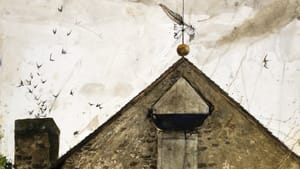Stay in the Loop
BSR publishes on a weekly schedule, with an email newsletter every Wednesday and Thursday morning. There’s no paywall, and subscribing is always free.
Wyeth’s most enduring legacy
Brandywine Museum of Art presents Andrew Wyeth: Home Places

What we pass by everyday becomes ubiquitous, like wallpaper, so familiar it simply doesn’t register. But there are people who rarely turn off their vision to the sights we flatten or eliminate. Exploring how one artist sees is the tantalizing premise amply delivered in Andrew Wyeth: Home Places.
On view through mid-July, this recently opened exhibition at the (recently renamed) Brandywine Museum of Art examines that artist’s depiction of a group of old houses in and around Chadds Ford, Pennsylvania. For seven decades, Andrew Wyeth (1917-2009) found emotion, inspiration, and sustenance in these buildings that others might overlook.
Wyeth case studies
Curated by William L. Coleman, Home Places celebrates the exteriors in the landscape; there are no interiors here. The exhibition is organized into seven sections of sub-themes that Coleman calls “case studies,” each focused on a particular house and composed of preliminary studies, drawings, watercolor sketches, and a finished artwork.
The case studies include some of the familiar buildings in the Wyeth oeuvre that he portrayed over and over: the Kuerner House (to which he was very attached), Big Bend (home of George “Frolic” Weymouth), Painters Folly (a markedly different Italianate building), Barnes Brinton House, and Brinton’s Mill, the Revolutionary War-era building where the Wyeths lived. This last is the exhibition’s largest case study, renovated from the semi-ruined state in which Wyeth first saw and depicted it.
Fundamental abstractions
Many of these houses were made of found materials—fieldstone and rock, not quarried blocks—that were rough, uneven, and often irregular. Those skillfully manipulated raw materials were things Wyeth found particularly engaging to document, using both representation (often shortsightedly cited as his sole artistic niche) and abstraction, which Coleman posits (and proves) was fundamental to the artist’s way of seeing.
In fact, this exhibition should put to rest any mistaken impression that Wyeth eschewed abstraction. In fact, large portions of his work are totally abstract, something the artist saw as an indispensable part of his practice. Coleman also notes that Wyeth painted while listening to music (his sister Ann was a composer), and the artist especially liked Sibelius, Beethoven, and Bach. In an interesting musical analogy, Coleman feels that the artist’s tempera works are like Bach’s music—intricate and highly constructed—while the watercolors are more like Beethoven’s, with emotion readily accessible.
Surprisingly, of the 49 pieces on view (most never seen before), 22 are studies, sketches, or drawings, and 22 are those impressive watercolors. Unlike oil or tempera, which can be reworked, watercolor is an unforgiving medium, immediate and permanent once on the paper. Wyeth is justly lauded for his meticulous dry brush and tempera pieces, but he also worked frequently and freely in watercolor, with great virtuosity. Since works on paper are light-sensitive, these watercolors will not be seen again for years.
The lure of close looking
Home Places shows only a fraction of the 7,000 objects in the Andrew and Betsy Wyeth Collection from the museum’s Wyeth Foundation for American Art, which came to fruition in 2022. This was a partnership envisioned by Betsy James Wyeth (1921-2020), the artist’s wife, and her bequest of this family collection has also created the Wyeth Study Center, located jointly at the Brandywine and the Farnsworth Art Museum (Rockland, Maine).
There’s an online curator’s tour of the exhibition, which is only the first of a series of projects that Coleman and his team of three will undertake. Plans include a deep dive into Betsy’s own substantial creative legacy and the huge task of publishing a catalogue raisonné: a comprehensive, annotated listing of all known Wyeth works.
It’s especially illuminating to pick one of the exhibition’s case studies and spend extended time with it. Such “close looking” was seminal to Wyeth’s artistic practice, and this impeccably executed exhibition provides renewed agency to consider our surroundings rather than letting them fade into the background, stripping the everyday of the miraculous. Wyeth’s legacy to us all—possibly his most enduring—is that we should look and truly see.
What, When, Where
Andrew Wyeth: Home Places. $6-$18. Through July 13, 2023, at the Brandywine Museum of Art, 1 Hoffman’s Mill Road, Chadds Ford. (610) 388-2700 or brandywine.org.
Accessibility
The entire museum (including the Millstone Café) is wheelchair accessible, with accessible parking, barrier-free entrance, and available wheelchairs. Service animals welcome.
Masks are not required.
Sign up for our newsletter
All of the week's new articles, all in one place. Sign up for the free weekly BSR newsletters, and don't miss a conversation.

 Gail Obenreder
Gail Obenreder